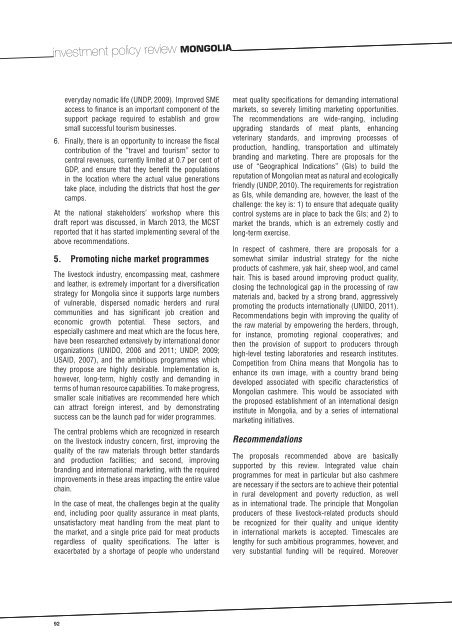UNCTAD-Mongolia
UNCTAD-Mongolia
UNCTAD-Mongolia
Create successful ePaper yourself
Turn your PDF publications into a flip-book with our unique Google optimized e-Paper software.
investment policy review MONGOLIA<br />
everyday nomadic life (UNDP, 2009). Improved SME<br />
access to finance is an important component of the<br />
support package required to establish and grow<br />
small successful tourism businesses.<br />
6. Finally, there is an opportunity to increase the fiscal<br />
contribution of the “travel and tourism” sector to<br />
central revenues, currently limited at 0.7 per cent of<br />
GDP, and ensure that they benefit the populations<br />
in the location where the actual value generations<br />
take place, including the districts that host the ger<br />
camps.<br />
At the national stakeholders’ workshop where this<br />
draft report was discussed, in March 2013, the MCST<br />
reported that it has started implementing several of the<br />
above recommendations.<br />
5. Promoting niche market programmes<br />
The livestock industry, encompassing meat, cashmere<br />
and leather, is extremely important for a diversification<br />
strategy for <strong>Mongolia</strong> since it supports large numbers<br />
of vulnerable, dispersed nomadic herders and rural<br />
communities and has significant job creation and<br />
economic growth potential. These sectors, and<br />
especially cashmere and meat which are the focus here,<br />
have been researched extensively by international donor<br />
organizations (UNIDO, 2006 and 2011; UNDP, 2009;<br />
USAID, 2007), and the ambitious programmes which<br />
they propose are highly desirable. Implementation is,<br />
however, long-term, highly costly and demanding in<br />
terms of human resource capabilities. To make progress,<br />
smaller scale initiatives are recommended here which<br />
can attract foreign interest, and by demonstrating<br />
success can be the launch pad for wider programmes.<br />
The central problems which are recognized in research<br />
on the livestock industry concern, first, improving the<br />
quality of the raw materials through better standards<br />
and production facilities; and second, improving<br />
branding and international marketing, with the required<br />
improvements in these areas impacting the entire value<br />
chain.<br />
In the case of meat, the challenges begin at the quality<br />
end, including poor quality assurance in meat plants,<br />
unsatisfactory meat handling from the meat plant to<br />
the market, and a single price paid for meat products<br />
regardless of quality specifications. The latter is<br />
exacerbated by a shortage of people who understand<br />
meat quality specifications for demanding international<br />
markets, so severely limiting marketing opportunities.<br />
The recommendations are wide-ranging, including<br />
upgrading standards of meat plants, enhancing<br />
veterinary standards, and improving processes of<br />
production, handling, transportation and ultimately<br />
branding and marketing. There are proposals for the<br />
use of “Geographical Indications” (GIs) to build the<br />
reputation of <strong>Mongolia</strong>n meat as natural and ecologically<br />
friendly (UNDP, 2010). The requirements for registration<br />
as GIs, while demanding are, however, the least of the<br />
challenge: the key is: 1) to ensure that adequate quality<br />
control systems are in place to back the GIs; and 2) to<br />
market the brands, which is an extremely costly and<br />
long-term exercise.<br />
In respect of cashmere, there are proposals for a<br />
somewhat similar industrial strategy for the niche<br />
products of cashmere, yak hair, sheep wool, and camel<br />
hair. This is based around improving product quality,<br />
closing the technological gap in the processing of raw<br />
materials and, backed by a strong brand, aggressively<br />
promoting the products internationally (UNIDO, 2011).<br />
Recommendations begin with improving the quality of<br />
the raw material by empowering the herders, through,<br />
for instance, promoting regional cooperatives; and<br />
then the provision of support to producers through<br />
high-level testing laboratories and research institutes.<br />
Competition from China means that <strong>Mongolia</strong> has to<br />
enhance its own image, with a country brand being<br />
developed associated with specific characteristics of<br />
<strong>Mongolia</strong>n cashmere. This would be associated with<br />
the proposed establishment of an international design<br />
institute in <strong>Mongolia</strong>, and by a series of international<br />
marketing initiatives.<br />
Recommendations<br />
The proposals recommended above are basically<br />
supported by this review. Integrated value chain<br />
programmes for meat in particular but also cashmere<br />
are necessary if the sectors are to achieve their potential<br />
in rural development and poverty reduction, as well<br />
as in international trade. The principle that <strong>Mongolia</strong>n<br />
producers of these livestock-related products should<br />
be recognized for their quality and unique identity<br />
in international markets is accepted. Timescales are<br />
lengthy for such ambitious programmes, however, and<br />
very substantial funding will be required. Moreover<br />
92




